Dogs have been an important part of families since a long time. From being watch-dogs to family companions, dogs have been a support to mankind. With the electronics industry growing at such a fast pace, electronics for animals has not been far behind. Humans are using electronics for their pets to simplify their own lives and the security of their pets.
Microchipping
A microchip implant is an identifying integrated circuit (IC) placed under the skin of an animal. It is about the size of a grain of rice and uses passive radio frequency identification (RFID) technology, and is also known as a passive integrated transponder (PIT) tag.
Externally-attached microchips such as RFID ear-tags are commonly used to identify farm and ranch animals other than horses. Some external microchips can be read with the same scanner that is used with implanted chips. The veterinarian injects the chip with a syringe and records the chip’s unique identification (ID) number of the anaesthetic. A test scan is done to ensure the operation has been done correctly.
An enrolment form is completed with chip ID, owner contact information, pet name and description, veterinarian contact information and an alternate emergency contact designated by the pet owner. Some shelters and vets designate themselves as the primary contact to remain informed about possible problems with the animals they place.
The form is sent to a registry, which may be the chip manufacturer, distributor or an independent entity; some countries have a single official national database. For a fee, the registry typically provides 24/7 toll-free telephone service for the life of the pet. Some vets leave registration to the owner, usually done online, but a chip without current contact information is essentially useless.
The owner receives a registration certificate with the chip ID and recovery service contact information. The information can also be imprinted on a collar tag worn by the animal.
Authorities and shelters examine strays for chips, providing the recovery service with the ID number, description and location so they may notify the owner or contact. An owner can also report a missing pet to the recovery service, as vets look for chips in new animals and check with the recovery service to see if it has been reported as lost or stolen.

Many veterinarians scan an animal’s chip on every visit to verify correct operation. Some use the chip ID as their database index and print it on receipts, test results, vaccination certifications and other records.
The microchip
A microchip implant is a passive RFID device. It remains inactive until it is powered by the scanner as it lacks an internal power source. The microchip contains three elements: a chip (an IC), a coil inductor (possibly with a ferrite core) and a capacitor.

The chip contains unique identification data and electronic circuits to encode the information. The coil acts as the secondary winding of a transformer, receiving power inductively coupled to it from the scanner. The coil and capacitor together form a resonant LC circuit tuned to the frequency of the scanner’s oscillating magnetic field to produce power for the chip. The chip then transmits data back through the coil to the scanner. These components are encased in a biocompatible soda-lime or borosilicate glass, and hermetically sealed. Barring rare complications, dogs and cats are unaffected by these.
In dogs, the chip is usually inserted under the skin at the back of the neck, between the shoulder blades on the dorsal midline. It can often be felt under the skin. Thin layers of connective tissues form around the implant and hold it in place.
Implanted microchips can distort magnetic resonance imaging (MRI), including those of the spinal cord.
Some disadvantages of microchipping are:
1. Chips could move and cause a variety of problems.
2. Different brands of microchips need different scanners.
3. All places do not have the correct scanners needed or any scanners at all.
4. Foreign body put under the skin has a risk of causing tumours.
Universal scanners have been introduced that detect microchips resonating at multiple frequencies.
According to Dr Gautam Unny (B.V.Sc, M.I.S.V.S), microchipping has huge potential. Only one per cent of dogs are microchipped in India, whereas all can be. Also, every shelter and clinic requires a scanner.
Wireless fencing
The main unit/transmitter for the wireless dog fence plugs into a regular outlet in your home and emits a radio signal from that location, which becomes the centre of a safe zone. The radio signal has limited range, which can be adjusted from about 9.1m to 45.7m (30 feet to 150 feet), and this circle is your safe zone.

The wireless dog fence comes with a special collar that the dog wears. It contains a receiver, which receives signal from the main unit. As long as the collar is receiving a signal, the dog is free to be anywhere in the safe zone. When the dog approaches the outer perimeter of the safe zone and moves into the warning zone, he or she receives a warning beep. If the dog continues to move away from the main unit and does not move towards the centre of the safe zone (the transmitter), the canine receives a static correction that is not harmful but does startle him/her. With a little training, the dog learns to move away from the boundaries at the sound of the warning beep and avoids static correction.
Safe zone of the wireless dog fence, because of its design, is necessarily a circle. It cannot be adjusted to be any other shape. This is the wireless dog fence’s most-limiting characteristic, because in some cases, a circular-shape safe area just does not work.
Petnet smartfeeder

Petnet is one of the most famous smartfeeders available on the Internet today. With the system and feeder, you can manage multiple things like the time the pet is fed, the portion he or she is to receive, determine ingredients that are important in the diet and have automatic delivery so you do not run out of food.
By using the smartfeeder application, you can get meal confirmations, details on remaining food supply and preset times for feeding. You can also feed your pet from anywhere using a smartphone. The system lets you choose food based on age, weight, breed and activity level to make healthier decisions for the pet.
The feeder uses a Wi-Fi module with IEEE standard 802.11 b/g/n at 2.4GHz. It also has a built-in rechargeable battery and comes with a chew-resistant USB cable and AC adaptor. The application requires iOS 8 or later for iPhone users.

FitBark

FitBark is a health-monitoring device that monitors a dog’s everyday activity and sleep. It turns all data into BarkPoints so you can track progress. One can open the application and get real-time updates on the dog and see if the dog is sleeping, walking or running.

It uses a Broadcom chip for processing and a low-energy Bluetooth module with Bluetooth 4.0 for synchronisation. It uses a 3-axis accelerometer to detect movement and has a rechargeable lithium-ion-polymer battery. The application requires iOS 8 or later for iPhone users and Android 4.4 or later with Bluetooth 4.0 for Android users.
Electronic SmartDoor
Electronic SmartDoor gives the pet a key to the house so he or she can come and go as wanted. Using RF technology, SmartDoor reads the unique signal of SmartKey worn on the pet’s collar and triggers the battery-power-driven flap to unlock. When SmartDoor no longer senses SmartKey, the flap automatically locks back into place. Each key is programmed to only let that pet use the door, so other pets or stray animals cannot use the pet door.

SmartDoor can detect up to five programmed SmartKeys, which are waterproof, and also operates in two other modes: fully-locked mode and unlocked mode. Locked mode does not allow entry or exit for any pet and unlocked mode allows entry and exit for all pets.
Akul Sabharwal is an electronics and communication engineer. He is currently working as R&D head at Sammi Electronics India Pvt Ltd








